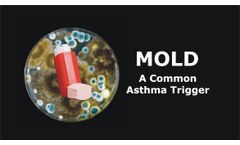Exposure Level Articles & Analysis: Older
43 news found
Fungal infections typically occur in people with a weakened or suppressed immune system, but exposure to elevated levels of fungi can cause other concerns for almost everyone. This is due to the fact that breathing elevated levels of fungi can cause respiratory irritation, allergies, and act as an asthma trigger for some people with the ...
“Poor IEQ is not just a comfort issue, exposure to elevated levels of biological contaminants, particulates, or chemicals can result in health concerns, infections, and learning challenges. ...
“This is why CDC cautions that misdiagnoses or delayed diagnoses can cost lives. Exposure to elevated levels of fungi can also act as a respiratory irritant, allergen, or even an asthma trigger for some people with the condition. ...
While mold is a natural part of the environment, exposure to elevated levels of it in schools, work environments, and other places where people spend time can trigger asthma for some asthmatics, and cause various respiratory issues for others. ...
While mold is a natural part of the environment, exposure to elevated levels of it in homes, schools, work environments and other places where people spend time can trigger asthma for some asthmatics, and cause various respiratory issues for others. The National Institute for Occupational Safety and Health (NIOSH) states that studies indicate ...
There are many known asthma triggers, but one of the more common ones is exposure to elevated levels of mold. This information is important for asthmatics, especially those living in Puerto Rico which has some of the highest asthma rates in the United States. ...
Their newest production discusses mold as a common asthma trigger and potential exposure risks in homes, schools and work environments. “8% of adults and 6.5% of children have asthma according to the Centers for Disease Control and Prevention,” said Paul Cochrane, President of Cochrane & Associates and the IAQ Video Network. ...
Whether by viruses or pathogens new or undiscovered, COVID-19 has demonstrated how quickly pandemic-level exposure can be achieved, once the human barrier has been breached. ...
Their newest production discusses various health concerns associated with building occupant exposures to elevated levels of indoor mold. “While mold is a natural part of the environment and people are exposed to it on a daily basis, exposure to high levels of mold in the air people breathe can lead to health issues for ...
The EPA provides the following health effects and symptoms often associated with exposure to VOCs. Health effects may include: · Eye, nose and throat irritation · Headaches, loss of coordination and nausea · Damage to liver, kidney and central nervous system · Some of these chemicals can cause cancer in animals and ...
Yet urban areas are characterised by increased levels of pollutants and fewer green spaces. Several studies have linked exposure to urban green spaces to improved physical and mental health and wellbeing1. ...
Although many people may be exposed to it without getting sick, people with weakened immune systems or lung diseases are at higher risk of developing health problems due to exposure. These may include allergic reactions, lung infections, and infections in other organs. ...
Recent research into the impact of different levels of noise on 75 volunteers reveals that disturbed sleep caused by night-time aircraft noise can damage blood vessels and increase the levels of stress hormones. ...
Kelly Ferguson, a postdoctoral research fellow, and John Meeker, associate professor of environmental health sciences and associate dean for research at the School of Public Health, along with their team, tested urine samples from pregnant women and found an association between the presence of phthalates and increased levels of biomarkers of oxidative stress. "It is not fully ...
Children born to mothers exposed during pregnancy to higher levels of the chemicals, butylbenzyl phthalate (BBzP) and di-n-butyl phthalate (DnBP) had a 72 percent and 78 percent increase in risk of developing asthma between age 5 and 11, respectively, compared with children of mothers with lower levels of exposure, the researchers found. ...
” Occupational asthma results from exposure to allergens or irritants on the job and according to the National Institutes of Health (NIH), more than 250 substances are known or believed to cause or exacerbate work-related asthma. ...
The new study brings to light the importance of CF patients avoiding exposure to elevated levels of Aspergillus in their homes, schools and businesses. ...
Although childhood asthma cannot be cured, eliminating exposure to high levels of mold and other potential links can make a tremendous difference in a child’s health. “Unfortunately, many children live in homes and attend daycare or school in buildings that have suffered water damage or elevated humidity levels,” reports ...
Approximately one million children today are affected by lead poisoning, but when you know what to look for and what to do, lead poisoning is 100% preventable. Major source of lead exposure among children is lead-based paint, including lead-contaminated dust and paint chips, found in deteriorating buildings. ...
The six-mile high eruption from Eyjafjallajökull produced a large cloud of ash that spread over Europe, which led to worries about the inhalation of tiny, sharp ash particles carrying acids and toxic compounds, such as fluorine and arsenic.1 This study builds on past research, which has suggested that ash may increase respiratory health problems, by exploring its effects at a cellular ...











